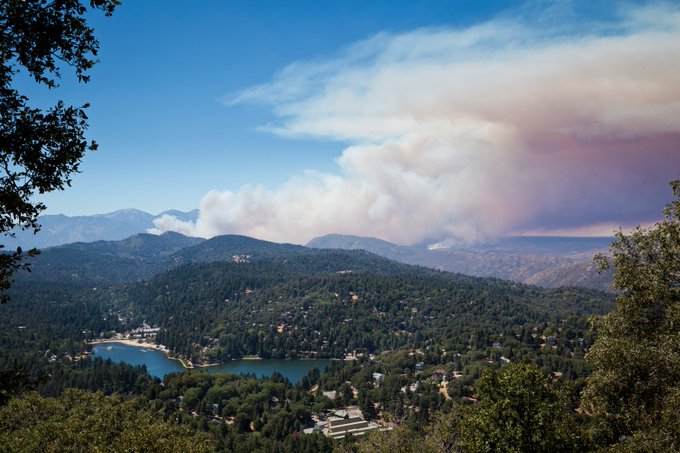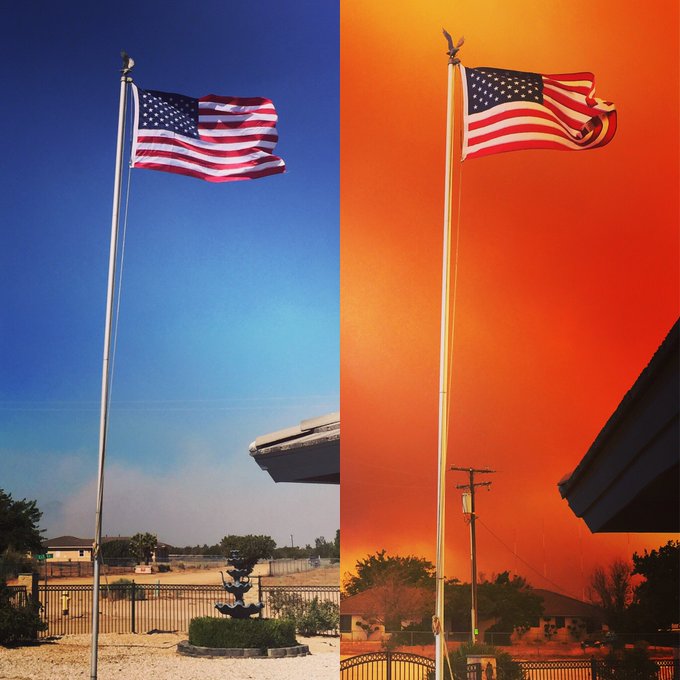HESPERIA, Calif. — Tens of thousands of Californians are anxiously awaiting word if their homes have been destroyed and beloved animals killed by a fast-growing wildfire outside San Bernardino.
Firefighters don’t yet know how many homes or other buildings have been destroyed, or how many animals have killed by the smoke and uncontained flames from the Blue Cut Fire, which has burned more than 30,000 acres in 24 hours.
As of Wednesday morning, the fire was about the size of San Francisco. And the worst of the state’s wildfire season is yet to come. September and October are usually hot, dry and windy, providing the kindling needed to fan such flames.
Firefighters had little good news to share Wednesday: “There will be a lot of families that come home to nothing,” said San Bernardino County Fire Chief Mark Hartwig.
Among those are Scott and Michelle Keeney, who lost both their home and the historic Route 66 diner the Summit Inn on Cajon Pass.
"I was angry last night, but I'm OK right now. This is just a sad reality of where we live," Michelle Keeney said Wednesday morning while walking through the remnants of their home.
More than 82,000 people have been told to leave or stay away from their homes, many of them fleeing the flames without the chance to bring along pets or livestock. Others who were at work when the fire blew up weren’t permitted to return home to gather pets or personal items. Firefighters say 35,000 homes have been evacuated and Interstate 15 is closed in both directions in the Cajon Pass area.
“There’s a lot of anxiety,” said San Bernardino Second District Supervisor Janice Rutherford, who represents the area. “People are worried and stressed. They are eager to get back to their homes. People are worried because they’ve had to leave animals behind.”
Think about it this way: What if you were told your house, right now, was in danger of being destroyed. You can’t go back there, and you can’t change what’s going to happen. All you can do is wait, dozens of miles away, through anxious hours and days to find out if all your possessions are gone and your pets dead. And to top it all off, you can see the smoke rising.
“The agony of waiting is the hardest part,” said Geoff Hinds, CEO of the San Bernardino County Fair, where about 300 evacuated animals are waiting, from horses and goats to llamas, chickens and tortoises. Cats and dogs are being kept at a different facility.
“This is a pretty tough group, but it obviously takes a toll and is a tragic experience, especially for those who don’t know if they have anything to go back," he added.
Jim Morrison was among people evacuated near Hesperia, but he was able to check on his home Wednesday. It was fine.
"I'm just glad it's still standing. Everything else is burning too much," said Morrison, 58.
Erin Smith, 45, also was evacuated from her home near Hesperia. She also was relieved to find her home intact, but she was still visibly emotional.
"It was just a scary thing and we didn't know what would happen at all," she said. "I never want this to happen again. I hated it."
The anxiety means all eyes turn to the firefighters on the ground and in the air as they scrape, chop, clear and drench vegetation to halt the fire’s spread. As of Wednesday morning, more than 1,300 firefighters were working the fire, along with 10 air tankers, eight helicopters and more than 150 fire engines. At a news conference, veteran firefighters said they’ve never seen a wildfire move as fast as this one.
“The firefighters are working harder that you can possibly imagine human beings can work,” Rutherford said. “This fire is behaving very erratically and it’s giving them a real challenge.”
On Tuesday, two firefighters suffered minor injuries after they and four others were trapped by fast-moving flames while assisting with evacuations and defending homes in Swarthout Canyon. The six took shelter in a nearby structure and were eventually able to escape the area. The two injured firefighters were treated and released from an area hospital and returned to fighting the blaze, authorities said.
The firefighters who were briefly trapped are part of two San Bernardino County Fire companies that were assigned to an area northwest of Cajon Boulevard. One of their fire engines sustained moderate fire damage, officials said.
The blaze began at Old Cajon Boulevard near Blue Cut for which the wildfire is named.
While the cause is unknown, officials don’t believe the nearby Pilot Fire helped spark it. That 8,000-plus-acre fire burned for about a week and was fully contained on Tuesday, when the Blue Cut Fire ignited.
Multiple emergency shelters for both people and animals have been opened for evacuees, and AirBnB is helping connect evacuees with free lodging.
The Blue Cut Fire is one of a handful of large wildfires burning in drought-stricken California, which again on Wednesday saw high temperatures that allow fires to grow rapidly, especially in areas with lots of dead trees or dry brush.
According to U.S. Forest Service officials, there’s at least 66 million dead trees across California, caused largely by four straight years of severe drought, a dramatic rise in bark beetle infestation and warmer temperatures that are leading to historic levels of tree die-off.
The Blue Cut Fire, while devastating, is nowhere near the worst fire in California’s recorded history. That dubious honor belongs to the 2003 Cedar Fire near San Diego, which burned more than 270,000 acres, destroyed nearly 3,000 homes and killed 15 people.
Atagi reports for The (Palm Springs, Calif.) Desert Sun.





